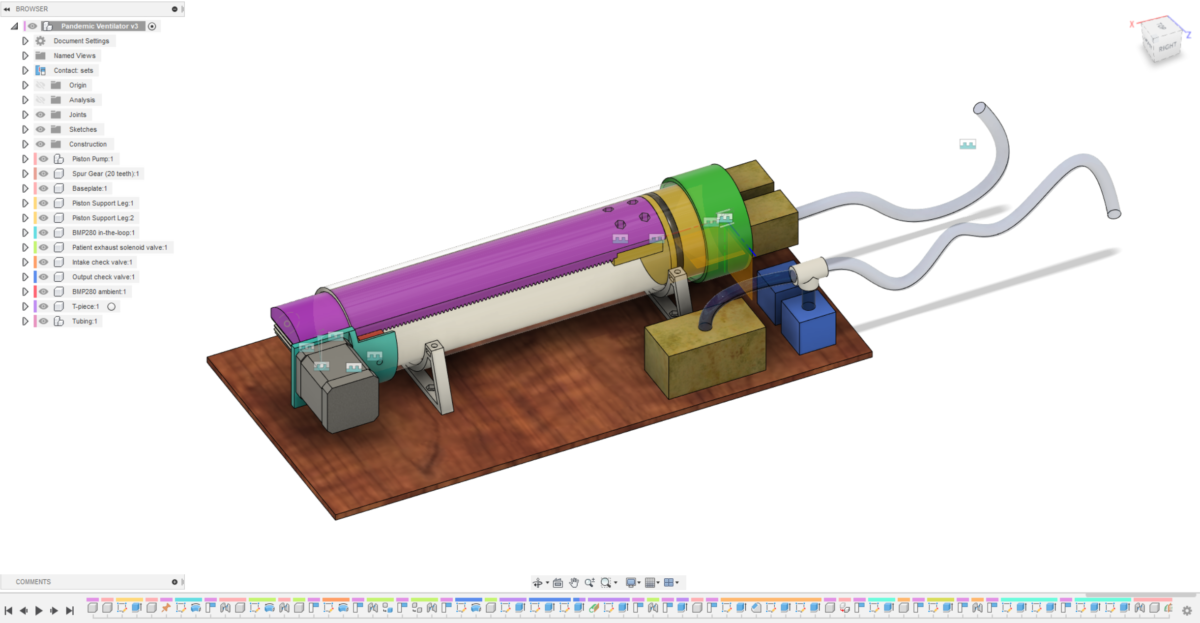I’m dumping these things in my “own” space to avoid polluting other spaces inadvertently. All are encouraged to use whatever is of value here for whatever purpose they see fit. The device involves the following ideas:
- The “heart” of the device is a stepper motor driving a piston pump via a rack and pinion. A piston pump is positive displacement, so it allows you to set tidal volume.
- A solenoid valves opens to allow the patient to exhale, but it closes once the pressure reaches the set PEEP pressure. This allows maintaining PEEP, which I currently understand is vital for ARDS patients
- 2 Absolute pressure sensors, BMP280, are used. These are widely available, cheap, and reliable, and provide good resolution. This is something I’m familiar with and that should work, but other options may exist I don’t know of. Electronic feedback is absolutely required though, an anolog gauge won’t work.
- I would personally do programming on a Raspberry Pi in Python. This allows relatively easy interfacing with sensors and actuators. For the interface I would use Keyboard+Screen+Mouse, via a GUI application running on the Pi. This eliminates the need for interfacing hardware like buttons and knobs, and obviates the need to mount those. I did this before for my Force-Extension machine you can see here.
The following “vitamins” are required:
- Stepper motor, currently Nema17
- Stepper driver, DRV8825 or similar.
- 2 check valves to make the pump work
- 1 solenoid valve to depressurize patient side. Must be closed in time to maintain PEEP.
- 2 BMP280 sensors, only for pressure. One to measure the patient circuit, the other for ambient air pressure. This must be done because all pressures mentioned in resources are relative to ambient, or so I understand, while BMP280 is an absolute sensor
- Hosing and fittings, though this can possibly be done with 3D printed or custom lathed posts and hoseclamps
- Warning light?
- Beeper?
The device as presented won’t actually work in most cases. This is because hospitals supply pure O2 at 440kPa pressure, which easily overwhelms the stepper and also causes the two check valves to “short circuit” 440kPa directly to the patient. The device is for unpressured source gas only. For pressurized source gas a kind of dosing solution is required, which I will work on. A device to mix pure O2 with room air to supply any FiO2 is also highly preferable.
Files here. If you need another format let me know.

Also think of the need to synchronize with the patient’s inspiration efforts. Can the rack and pinion keep up with that? The two goals of mechanical ventilation is to take over or greatly reduce the patient’s work of breathing and provide adjustable levels of inspired oxygen levels to address hypoxic respiratory failure.
The speed of the rack and pinion is an issue, also when considering higher respiratory rates and higher I:E ratios. I have heard though that combining high breaths per minute with high I:E ratios is not commonly done. I’m currently planning to use a Nema17 stepper with integral 5:1 gearbox. That produces 3Nm give or take. I think the speed on that will be borderline, but I think the next step is to use Nema23 motors. Those also have 3Nm of torque, but without a gear reduction, so they should be more than fast enough.
When it comes to adaptive breathing, I think there’s one scenario where the patient is sedated and paralyzed. In that case though I would imagine you’d also use a “normal” ventilator, I don’t know if hospitals can keep many more patients sedated than how many they can ventilate.
The other scenario indeed involves adapting to the patient, I think that can be done by sensing the slight drop in pressure that occurs when the patient tries to inhale.